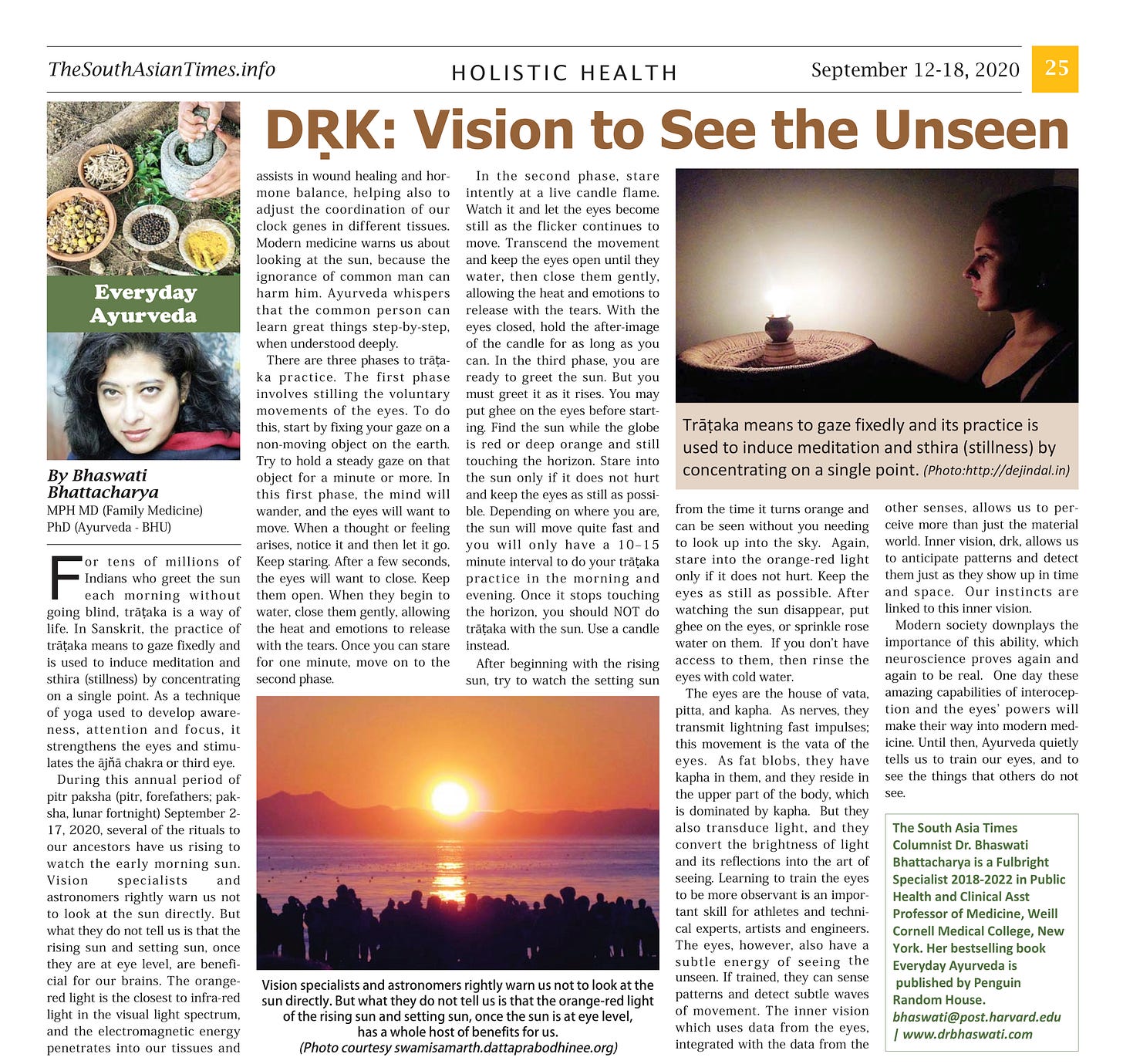dṛk: Vision to See the Unseen
The eyes can detect subtle energy, to see the typically unseen. But only if you allow your senses to be as strong as your analytical brain, which is always trying to make everything concrete to stay in control. This is why scientists are so blind - they only see with their brains trained to allow what they believe into their eyes.
Drk: Vision to See the Unseen
For hundreds of millions of Indians who greet the sun each morning without going blind, trāṭaka is a way of life. In Sanskrit, the practice of trāṭaka means to gaze fixedly and is used to induce meditation and sthira (stillness) by concentrating on a single point. As a technique of yoga used to develop awareness, attention and focus, it strengthens the eyes and stimulates the ājňā chakra or third eye.
During this annual period of pitr paksha (pitr, forefathers; paksha, lunar fortnight) September 2-17, 2020, several of the rituals to our ancestors have us rising to watch the early morning sun. Vision specialists and astronomers rightly warn us not to look at the sun directly. But what they do not tell us is that the rising sun and setting sun, once they are at eye level, are beneficial for our brains. The orange-red light is the closest to infra-red light in the visual light spectrum, and the electromagnetic energy penetrates into our tissues and assists in wound healing and hormone balance, helping also to adjust the coordination of our clock genes in different tissues. Modern medicine warns us about looking at the sun, because the ignorance of common man can harm him. Ayurveda whispers that the common person can learn great things step-by-step, when understood deeply.
There are three phases to trāṭaka practice. The first phase involves stilling the voluntary movements of the eyes. To do this, start by fixing your gaze on a non-moving object on the earth. Try to hold a steady gaze on that object for a minute or more. In this first phase, the mind will wander, and the eyes will want to move. When a thought or feeling arises, notice it and then let it go. Keep staring. After a few seconds, the eyes will want to close. Keep them open. When they begin to water, close them gently, allowing the heat and emotions to release with the tears. Once you can stare for one minute, move on to the second phase.
In the second phase, stare intently at a live candle flame. Watch it and let the eyes become still as the flicker continues to move. Transcend the movement and keep the eyes open until they water, then close them gently, allowing the heat and emotions to release with the tears. With the eyes closed, hold the after-image of the candle for as long as you can.
In the third phase, you are ready to greet the sun. But you must greet it as it rises. You may put ghee on the eyes before starting. Find the sun while the globe is red or deep orange and still touching the horizon. Stare into the sun only if it does not hurt and keep the eyes as still as possible. Depending on where you are, the sun will move quite fast and you will only have a 10–15 minute interval to do your trāṭaka practice in the morning and evening. Once it stops touching the horizon, you should NOT do trāṭaka with the sun. Use a candle instead.
After beginning with the rising sun, try to watch the setting sun from the time it turns orange and can be seen without you needing to look up into the sky. Again, stare into the orange-red light only if it does not hurt. Keep the eys as still as possible. After watching the sun disappear, put ghee on the eyes, or spritz rose water on them. If you don’t have access to them, then rinse the eyes with cold water.
The eyes are the house of vata, pitta, and kapha. As nerves, they transmit lightning fast impulses; this movement is the vata of the eyes. As fat blobs, they have kapha in them, and they reside in the upper part of the body, which is dominated by kapha. But they also transduce light, and they convert the brightness of light and its reflections into the art of seeing. Learning to train the eyes to be more observant is an important skill for athletes and technical experts, artists and engineers. The eyes however, also have a subtle energy of seeing the unseen. If trained, they can sense patterns and detect subtle waves of movement. The inner vision which uses data from the eyes, integrated with the data from the other senses, allows us to perceive more than just the material world. Inner vision, drk, allows us to anticipate patterns and detect them just as they show up in time and space. Our instincts are linked to this inner vision.
Modern society downplays the importance of this ability, which neuroscience proves again and again to be real. One day these amazing capabilities of interoception and the eyes’ powers will make their way into modern medicine. Until then, Ayurveda quietly tells us to train our eyes, and to see the things that others do not see.
week25. TheSouthAsianTimes
Obtain the .pdf version of this column by clicking on the image.
Dr. Bhaswati Bhattacharya is a Fulbright Specialist 2018‐2023 in Public Health. She serves as Clinical Asst Professor of Family Medicine in the Department of Medicine at Weill Cornell Medical College in New York, NY. Her bestselling book Everyday Ayurveda is published by Penguin Random House. To order an autographed copy, write to bhaswati@post.harvard.edu.
www.drbhaswati.com



